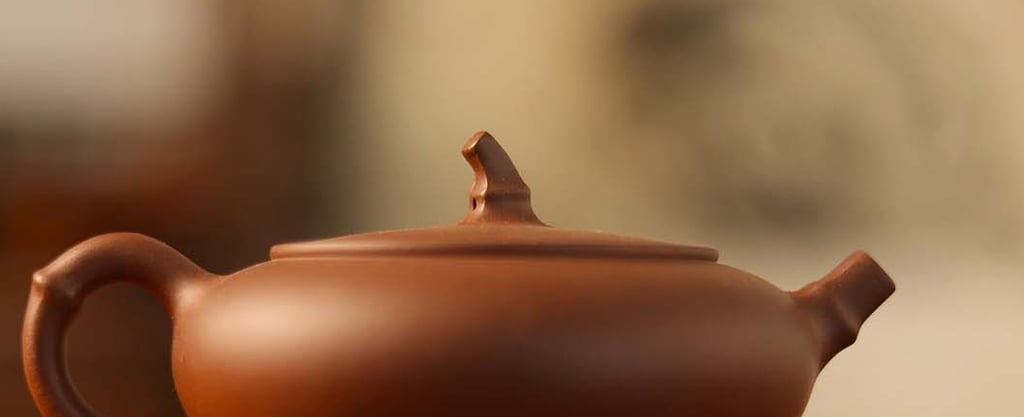Exploring the Decorative Art of the Yixing Teapot Knob
Yixing teapot knobs, integral to both function and aesthetics, are a canvas for craftsmanship and cultural expression. This blog explores their decorative evolution, from geometric to natural forms, and highlights the role of gemstones in enhancing the teapot’s visual appeal and significance.
YIXING TEAPOTS
Ever wondered why Yixing teapots are so revered, not just for brewing tea but as genuine pieces of art? And why something as small as a teapot knob holds so much importance in their design? The answer lies in a blend of functionality, craftsmanship, and cultural symbolism.
Yixing teapots have been cherished for centuries, known for their unique clay, ability to enhance tea flavour, and durability. But beyond their practical use, every detail—especially the teapot knob—tells a story of aesthetic refinement and artistic innovation. In this article, we’ll dive into the decorative art of the Yixing teapot knob, exploring its history, design significance, and the creativity behind it.
Understanding The Decorative Art of Yixing Teapot Knobs
Yixing Teapots, Cultural Artifacts, and Aesthetic Expression
For centuries, Yixing teapots have been more than just vessels for brewing tea—they’re cultural artefacts. Since the Ming Dynasty, these teapots have balanced practicality with artistic beauty. Scholars and intellectuals of the past didn’t just use them for tea; they saw them as reflections of their own values and philosophies.
The teapot knob, though small, plays a massive role in this balance. It’s not just a handle; it’s a focal point that completes the teapot’s design. Whether it’s geometric, bridge-shaped, or inspired by nature, every knob adds a unique flavour to the teapot’s overall appearance.
Today, the Yixing teapot knob remains a symbol of tradition meeting innovation, proving that even the smallest detail can carry deep cultural weight.
Yixing Pottery and the Role of Gemstones
You might have noticed some Yixing teapots with gemstone knobs. Why gemstones? Because they add a whole new layer of sophistication.
The famous "Five-Coloured Clay" of Yixing pottery, with shades of purple, red, and green, creates a rich, earthy canvas. When paired with a gemstone knob, the contrast is striking. The gemstone's bright colour and shine pop against the teapot’s matte surface, creating a balance that feels both natural and luxurious.
This isn’t just about aesthetics either. Gemstones are durable, symbolic, and deeply rooted in Chinese culture, making them the perfect choice for decorative elements on something as timeless as a Yixing teapot.
The Role of the Knob in Decorative Art
It’s easy to overlook the teapot knob, but it’s far more than just a handle for the lid. It’s a key decorative element that anchors the entire design.
Proportion is everything: If the knob is too large, it overwhelms the teapot. Too small, and it fades into the background.
Shape matters: Geometric knobs suit minimalist designs, bridge-shaped knobs bring elegance to detailed teapots, and natural-shaped knobs—resembling flowers or animals—add character and charm.
Over time, artisans have perfected the balance of form and function in knob design. They know that even the tiniest tweak to a knob’s size or shape can change how the entire teapot feels and looks.
Techniques and Innovations in Knob Decoration
So, how do artisans create these intricate Yixing teapot knobs?
Geometric Knobs: Clean, precise shapes that suit simple teapots.
Bridge-Shaped Knobs: Elegant designs often paired with ornate patterns.
Natural Knobs: Inspired by nature—think leaves, flowers, or even small animals.
Modern innovations have also introduced gemstone knobs, elevating traditional teapot designs with a touch of opulence. Whether it’s jade, agate, or quartz, each gemstone brings its own energy and visual appeal to the teapot.
These techniques showcase not just craftsmanship but an artist’s ability to tell a story through subtle details.
Conclusion
The decorative art of the Yixing teapot knob is proof that even the smallest detail can make a huge impact. It’s not just about looks—it’s about balance, harmony, and storytelling.
From classic geometric shapes to intricate natural designs and luxurious gemstone embellishments, the teapot knob remains a canvas for artistic expression. As artisans continue to experiment and innovate, these knobs ensure that Yixing teapots will remain timeless treasures for generations to come.
Next time you see a Yixing teapot, take a closer look at the knob. You’ll realise it’s not just a handle—it’s a masterpiece.
FAQs
Q: Why is the Yixing teapot knob so important?
A: It balances the teapot’s design, adds aesthetic value, and serves as a key focal point in the overall composition.
Q: Are gemstone knobs functional or just decorative?
A: They’re both! While they add elegance, gemstones are also durable, making them functional as well.
Q: What are the most common shapes for Yixing teapot knobs?
A: Geometric, bridge-shaped, and natural forms are the most popular.
Q: Can I customise a Yixing teapot knob?
A: Absolutely! Many artisans offer custom designs, allowing you to personalise your teapot.






